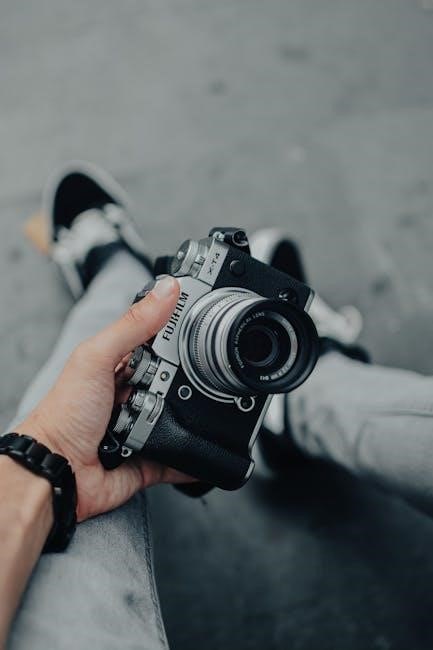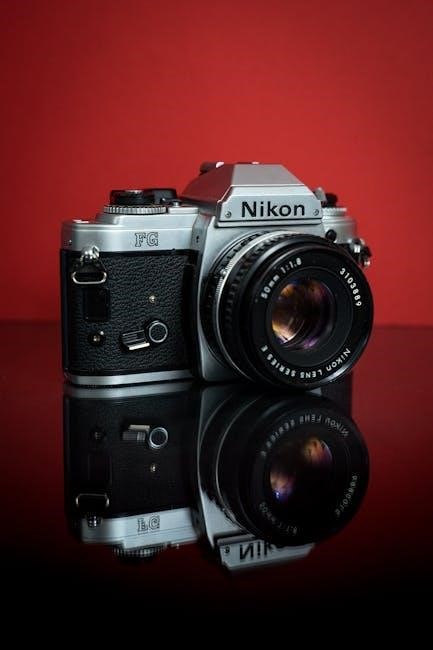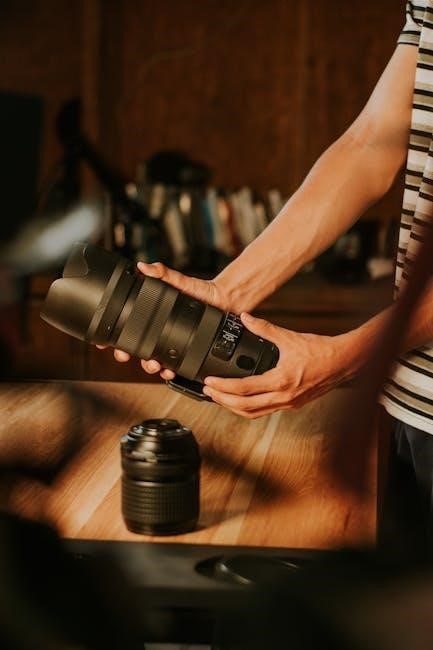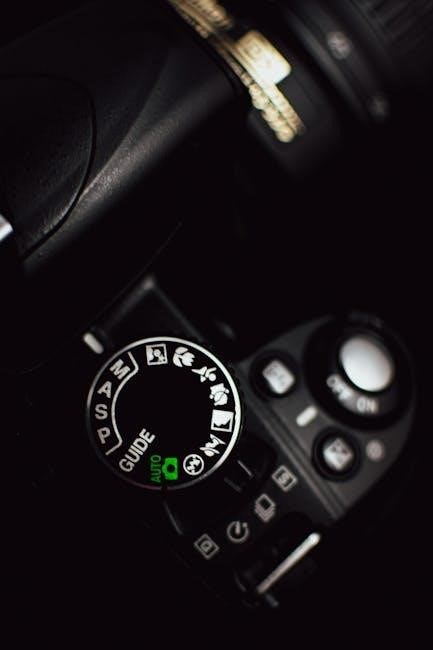
Welcome to the Nikon F4 user manual! This guide helps you master the Nikon F4, a professional SLR camera featuring advanced autofocus, Matrix Metering, and versatile exposure modes. Read this manual carefully to unlock its full potential and optimize your photography experience.
Overview of the Nikon F4 Camera
The Nikon F4 is a professional-grade 35mm SLR camera renowned for its durability, reliability, and advanced features. Introduced in 1988, it was a significant upgrade to Nikon’s F series, offering improved autofocus, Matrix Metering, and enhanced ergonomics. The camera is built with a robust design, making it suitable for heavy use in various environments. It features five exposure modes (Program, Aperture Priority, Shutter Priority, Manual, and Auto) and supports interchangeable lenses, ensuring versatility for different photography needs. The F4 also includes quiet film advance and a top shutter speed of 1/8000th of a second, catering to professionals and enthusiasts alike. Its user-friendly interface and customizable settings make it a favorite among photographers seeking precision and control. The Nikon F4 remains a testament to Nikon’s commitment to innovation and quality.
Importance of Reading the Manual
Reading the Nikon F4 user manual is essential to fully understand and utilize the camera’s advanced features. This comprehensive guide provides detailed explanations of the camera’s autofocus system, Matrix Metering, and exposure modes. By thoroughly reviewing the manual, users can master the camera’s operation, customize settings to their preferences, and troubleshoot common issues. The manual also offers insights into the camera’s shutter speed, film advance, and accessory compatibility. Whether you’re a professional or an enthusiast, the manual ensures you unlock the full potential of your Nikon F4. It is available in PDF format and multiple languages, making it accessible to a wide range of users. Take the time to read it carefully before using your camera to ensure optimal performance and photography results.
Nikon F4 Series Variations (F4, F4s, F4s High Speed)
The Nikon F4 series offers three distinct models to cater to different photography needs. The Nikon F4 is the base model, featuring advanced autofocus, Matrix Metering, and a robust build. The Nikon F4s adds enhanced features, including faster film advance and improved ergonomics. For professional photographers requiring high-speed performance, the Nikon F4s High Speed model offers an impressive 13 frames per second continuous shooting capability. Each variation maintains the core strengths of the F4 system while addressing specific user demands. Understanding these variations helps photographers choose the right model for their workflow and creative goals. This diversity ensures the Nikon F4 series remains versatile and adaptable to various shooting environments and applications.

Camera Overview and Features
The Nikon F4 is a professional-grade SLR camera known for its advanced autofocus, Matrix Metering, and versatility in shooting modes. Its robust construction ensures reliability for professional use.
Key Specifications of the Nikon F4
The Nikon F4 features a 45.7MP stacked CMOS sensor and EXPEED 7 processing engine, delivering exceptional image quality. It boasts Nikon’s most advanced autofocus system, utilizing deep learning technology for precise subject detection and 3D tracking. The camera supports a wide ISO range and offers shutter speeds up to 1/8000 sec. With Matrix Metering and multiple exposure modes, it ensures versatility in various lighting conditions. The F4 also supports silent and high-speed film advance, making it ideal for professional use. Its weather-sealed design and intuitive controls enhance durability and usability. The camera is compatible with a wide range of Nikkor lenses, offering flexibility for diverse photography needs. These specifications make the Nikon F4 a powerful tool for photographers seeking high performance and reliability.
Advanced Autofocus System
The Nikon F4 boasts an advanced autofocus system developed using deep learning technology, enabling precise subject detection and tracking. It can focus in extremely low light conditions, down to -9 EV, ensuring sharp images even in challenging environments. The system combines subject detection with 3D tracking, allowing it to dynamically adapt to moving subjects. This technology is particularly effective for capturing people, animals, and fast-moving objects. The autofocus algorithm continuously improves with use, enhancing accuracy and reliability. With compatibility across a wide range of Nikkor lenses, the F4 delivers exceptional autofocus performance for both stills and video. This feature makes it a powerful tool for professional photographers seeking superior control over their shots.
Matrix Metering and Exposure Modes
The Nikon F4 features an advanced Matrix Metering system, which analyzes light across multiple segments of the frame to provide precise exposure readings. This system is particularly effective in complex lighting conditions, ensuring balanced results. The camera offers five exposure modes: Program (P), Aperture Priority (A), Shutter Priority (S), and Manual (M). Program Mode offers automatic settings for quick shooting, while Aperture Priority allows control over depth of field, and Shutter Priority enables freeze or blur effects for motion. Manual Mode provides full creative control for experienced photographers. These modes, combined with Matrix Metering, make the F4 highly versatile for various photographic scenarios, ensuring optimal image quality and flexibility.
Shutter Speed and Film Advance
The Nikon F4 offers a wide range of shutter speeds, from 1/8000 of a second to 30 seconds, plus a Bulb mode for extended exposures. This flexibility allows photographers to capture everything from fast-moving subjects to creative long exposures. The F4 also features a quiet and smooth film advance mechanism, reducing vibration and noise during shooting, which is particularly beneficial for candid or wildlife photography. The camera supports film speeds from ISO 6 to 6400, ensuring compatibility with a variety of film stocks. Additionally, the F4s High Speed variant can shoot up to 6 frames per second, making it ideal for action and sports photography. With precise control over shutter speed and film handling, the F4 delivers professional-grade performance and reliability.

How to Use the Nikon F4
Mastering the Nikon F4 begins with understanding its intuitive controls. Use the mode dial to select from Program, Aperture Priority, Shutter Priority, or Manual modes. Adjust settings via the focus mode selector and metering modes for precise control. Refer to the manual for detailed guidance on optimizing camera functionality. This guide ensures you maximize the F4’s capabilities, whether you’re a professional or just starting out.
Basic Camera Operation
Mastering the Nikon F4 begins with understanding its fundamental operations. Start by familiarizing yourself with the camera’s controls, including the mode dial, focus mode selector, and metering modes. Load film by opening the back cover and aligning the film leader with the spool. Set the ISO using the dial on the right side. Use the viewfinder to frame your shot, ensuring the subject is within the autofocus area. Press the shutter button halfway to activate autofocus and metering, then fully depress it to capture the image. For optimal results, always refer to the manual for detailed instructions on customizing settings and troubleshooting common issues. Regular practice will help you unlock the F4’s full potential.
Manual Mode (M)
In Manual Mode (M), you gain full control over aperture and shutter speed, allowing for precise adjustments to suit your creative vision. To activate Manual Mode, rotate the mode dial to the “M” position. Use the aperture ring on the lens and the shutter speed dial to set your desired exposure. The LCD panel on the camera’s top displays the selected settings for easy reference. Manual Mode is ideal for experienced photographers who want complete control over their shots, especially in challenging lighting conditions or for artistic effects. When using Manual Mode, ensure the exposure needle aligns with the center mark for proper exposure. Experiment with different combinations to achieve the desired results. For optimal use, practice adjusting settings and review your images to refine your technique.
Aperture Priority Mode (A)
In Aperture Priority Mode (A), you set the aperture, and the camera automatically adjusts the shutter speed to ensure proper exposure. This mode is ideal for controlling depth of field while letting the camera handle the shutter speed. To use Aperture Priority Mode, rotate the mode dial to the “A” position. Adjust the aperture using the aperture ring on the lens. The camera will display the selected aperture and automatically set the shutter speed on the LCD panel. You can fine-tune exposure by using the exposure compensation button (+/−). This mode is perfect for creative control over aperture while maintaining ease of use. Experiment with different aperture settings to achieve your desired depth of field and lighting effects.
Shutter Priority Mode (S)
In Shutter Priority Mode (S), you set the shutter speed, and the camera automatically adjusts the aperture to achieve the correct exposure. This mode is ideal for controlling motion effects, such as freezing fast-moving subjects or creating blurred backgrounds. To use Shutter Priority Mode, turn the mode dial to the “S” position. Select your desired shutter speed using the shutter speed dial. The camera will automatically set the aperture based on the lighting conditions. You can also use exposure compensation to fine-tune the exposure by +/- 3 EV. Shutter Priority Mode is particularly useful for sports, wildlife, and action photography, allowing you to capture sharp images with precise control over motion and blur.
Program Mode (P)
In Program Mode (P), the Nikon F4 automatically selects both the shutter speed and aperture for optimal exposure. This mode is ideal for beginners or when you want to let the camera handle settings quickly. The camera uses its built-in metering system to analyze the scene and choose the best combination of shutter and aperture. You can still use exposure compensation to adjust the exposure by +/- 3 EV if needed. Program Mode offers flexibility while maintaining simplicity, making it a great option for everyday photography. It’s perfect for capturing sharp, well-exposed images without manual adjustments.
Using the Focus Mode Selector
The Nikon F4 features a Focus Mode Selector, allowing you to switch between manual focus and autofocus modes. Located on the front of the camera near the lens mount, this selector provides three options: M (Manual), S (Single Servo AF), and C (Continuous Servo AF). In Manual (M) mode, you control focus using the lens focus ring, ideal for precise adjustments. Single Servo (S) mode activates autofocus when the shutter is pressed halfway, suitable for stationary subjects. Continuous Servo (C) mode allows the camera to track moving subjects by continuously adjusting focus. Choose the mode based on your shooting needs for optimal results.
Understanding Metering Modes
The Nikon F4 offers three metering modes: Matrix Metering, Center-Weighted Metering, and Spot Metering. Matrix Metering divides the scene into five segments and balances exposure for optimal results. Center-Weighted Metering emphasizes the central area, useful for portraits. Spot Metering measures light from a small area, ideal for high-contrast scenes. To switch modes, press the metering mode button and rotate the command dial. Matrix Metering is the default and best for most situations, but Spot Metering is valuable for precise control. Experiment with these modes to achieve the desired exposure in various lighting conditions. Proper use of metering modes enhances your photography by ensuring accurate exposures tailored to your creative vision.
Adjusting ISO Settings
The Nikon F4 allows you to adjust ISO settings to suit various lighting conditions. The camera supports ISO ranges from 12 to 6400 in 1/3 increments. To change the ISO, press the ISO button on the top plate and rotate the command dial. Lower ISO settings (12-400) are ideal for bright lighting to prevent overexposure, while higher ISOs (800-6400) are better for low-light conditions but may introduce grain. Use the built-in flash or external lighting for additional support in low-light scenarios. Always review your images to ensure the desired balance between brightness and noise. Experimenting with ISO settings helps you achieve optimal results in diverse photographic situations. Proper ISO adjustment is key to capturing sharp, well-exposed images with the Nikon F4.
Using the Viewfinder
The Nikon F4’s viewfinder provides a clear and bright display of your scene, making composition and focus easier. Hold the camera steady and look through the viewfinder to frame your shot. The diopter adjustment ensures sharp visibility, even for those with vision impairments. The LCD panel inside the viewfinder displays key settings like aperture, shutter speed, and metering mode. Use the 5-segment matrix metering display to check exposure levels across the frame or switch to spot metering for precise light measurement. The viewfinder also shows focus indicators, confirming when your subject is in focus. Interchangeable focusing screens allow customization for specific photography needs, such as portrait or landscape work. Proper use of the viewfinder enhances your control over composition and exposure, ensuring better results with the Nikon F4.

Customizing Your Nikon F4
Customize your Nikon F4 to suit your photography style with adjustable settings. The diopter adjustment ensures sharp viewfinder visibility, while custom focus modes and interchangeable focusing screens enhance precision and control.
Custom Settings and Personalization
The Nikon F4 allows for extensive customization to tailor your shooting experience. Film speed settings can be adjusted to match your preferences, while exposure compensation ensures precise control over lighting. Custom functions enable you to modify camera behavior, such as focusing modes and metering patterns. Personalize your workflow by setting preferred defaults for ISO, aperture, and shutter speed. The F4s and F4s High Speed models offer additional customization options, including enhanced film advance speeds. By exploring these settings, you can adapt the camera to your unique photography style, ensuring a seamless and personalized experience. This level of customization makes the Nikon F4 a versatile tool for professionals and enthusiasts alike.
Navigating the Menu System
Navigating the Nikon F4’s menu system is straightforward, allowing you to access and adjust various camera settings efficiently. Use the directional pad to scroll through options, and press the center button to select a menu item. The rear control dial can be used to adjust values or settings quickly. Key menu sections include Custom Settings, Exposure Compensation, and Autofocus Modes. Sub-menus provide detailed control over specific functions, such as metering modes or ISO settings. By familiarizing yourself with the menu layout, you can make adjustments on the fly, ensuring optimal performance in any shooting scenario. This intuitive design makes it easy to tailor the camera to your photographic needs. Regular use will help you master the menu system, enhancing your overall shooting experience with the Nikon F4.
Configuring Autofocus Settings
Configuring the autofocus settings on your Nikon F4 allows you to optimize its performance for various shooting situations. Access the autofocus menu to choose between Single AF and Continuous AF. Single AF locks focus on a stationary subject, while Continuous AF tracks moving subjects. Adjust the AF sensitivity to customize how the camera responds to subject movement. You can also select focus areas using the focus area selector, ensuring the camera prioritizes the correct part of the frame. Customize AF modes to suit your style, whether you’re capturing portraits or dynamic action. Proper configuration ensures sharp focus and precise control, enhancing your photography results. Regularly reviewing and adjusting these settings will help you make the most of the Nikon F4’s advanced autofocus capabilities. Experiment with different configurations to find what works best for your creative vision.

Setting Up Exposure Compensation
Exposure compensation on the Nikon F4 allows you to fine-tune the camera’s metered exposure. Access the exposure compensation feature by pressing the exposure compensation button and turning the main command dial. This lets you adjust the exposure in increments of ±3 EV. Use the LCD panel to confirm your settings, as it displays the compensation value. For precise control, review the viewfinder, which also shows the adjustment. Reset to zero after use to avoid unintended effects in subsequent shots. Mastering exposure compensation ensures balanced lighting in challenging conditions, enhancing your creative control over the final image. Regular practice will help you use this feature intuitively, improving your photography results. Adjustments are quick and easy, making it a versatile tool for any situation.

Accessories for the Nikon F4
The Nikon F4 supports a wide range of accessories, including compatible lenses, external flash units, and remote shutter releases. These tools enhance functionality and versatility for professional photography needs.
Compatible Lenses for the Nikon F4
The Nikon F4 is compatible with a wide range of Nikkor lenses, including AI and AIS models. Prime lenses like the Nikkor 50mm f/1.4 offer exceptional sharpness and bokeh, while zoom lenses provide versatility. The camera also supports specialized lenses such as macro and telephoto options, making it ideal for various photography genres. Ensure lens compatibility to fully utilize the F4’s advanced features. Proper lens selection can significantly enhance image quality and creative control. Always choose lenses that align with your photography style and needs for optimal results.
External Flash and Lighting Options
The Nikon F4 supports various external flash and lighting options to enhance your photography. Dedicated Nikon flashes like the SB-24 and SB-25 are highly recommended for seamless integration with the camera’s iTTL system. These flashes offer precise control and advanced features like wireless operation. Additionally, third-party flashes can be used, though compatibility should be verified. For studio lighting, the F4 can be synchronized with external strobes using its PC sync terminal. Always ensure proper connection and settings for optimal performance. Using external lighting can significantly improve image quality, especially in low-light conditions or for creative effects. Experiment with different setups to achieve your desired results.

Remote Shutter Release
The Nikon F4 supports remote shutter release for precise control and reduced camera shake. Use the ML-3 Remote Shutter Release or the MC-12A Remote Cord to activate the shutter without touching the camera. This is ideal for low-light photography, long exposures, or macro shots. The ML-3 offers a 10-second delay to allow the camera to stabilize, while the MC-12A provides instant triggering. Both options ensure sharp images by eliminating vibrations caused by manual shutter pressing. For added convenience, these accessories are compact and easy to use, making them essential tools for professional and enthusiast photographers alike. Remote operation enhances your shooting experience and expands creative possibilities.
Other Compatible Accessories
Beyond lenses and flashes, the Nikon F4 can be enhanced with a variety of other compatible accessories to customize your workflow. The MB-20 Battery Grip extends shooting sessions by doubling the camera’s power capacity, while the MF-21 Data Back allows for date and time stamping on film. Additionally, the Nikon GP-1 GPS Unit enables geotagging for precise location tracking of your images. For studio work, the AS-4 Speedlight Adapter ensures seamless integration with external lighting systems. These accessories enhance functionality and expand the camera’s capabilities, making the Nikon F4 a versatile tool for both professionals and enthusiasts. Each accessory is designed to integrate seamlessly with the camera, ensuring optimal performance and uninterrupted creativity.

Maintenance and Troubleshooting
Regular cleaning of the camera and lens prevents dust and dirt buildup. Use a soft brush or cloth for the exterior and a microfiber cloth for the lens. For internal cleaning, consult a professional. Check the mirror and viewfinder for dust periodically. If issues arise, such as shutter malfunction or autofocus errors, refer to the troubleshooting guide in the manual or contact Nikon support. Preventative maintenance ensures optimal performance and longevity of your Nikon F4.
Cleaning the Camera and Lens
Regular cleaning and maintenance are essential to ensure optimal performance and longevity of your Nikon F4. Start by using a soft, dry brush or a microfiber cloth to gently remove dust and debris from the camera body and external components. For the lens, use a microfiber cloth and a small amount of lens cleaning solution. Avoid harsh chemicals or abrasive materials that could damage the lens coating. Avoid touching the lens surface to prevent oil from your skin leaving smudges. For internal cleaning, such as the mirror or viewfinder, consult a professional to avoid damaging sensitive components. Regularly cleaning your equipment ensures sharp, clear images and prevents dust buildup that could affect performance.
Troubleshooting Common Issues
Troubleshooting common issues with your Nikon F4 ensures optimal performance. If the camera fails to turn on, check the battery compartment and ensure batteries are installed correctly. For blurry images, inspect the lens for smudges or dust and clean it with a microfiber cloth. If the autofocus isn’t functioning, switch to manual focus and ensure the focus mode selector is set correctly. Error messages like “ERR” indicate issues with the camera’s internal system—consult the manual or contact a professional. Regular maintenance, such as cleaning the lens and camera body, helps prevent many common problems. Addressing issues promptly ensures your Nikon F4 continues to deliver exceptional results.

Updating Firmware (if applicable)
Updating the firmware on your Nikon F4 ensures access to the latest features and improvements. Check Nikon’s official website for firmware updates specific to your camera model. Download the update to a memory card using a card reader and a computer. Insert the card into the camera and follow the on-screen instructions to complete the update. Do not interrupt the process to avoid potential damage. After updating, verify the firmware version in the camera’s menu to confirm success. Regularly checking for updates keeps your F4 performing at its best. Visit Nikon’s support page for detailed instructions and to download the latest firmware securely.
Importance of Regular Maintenance
Regular maintenance is crucial for ensuring the Nikon F4 operates at its best. Clean the camera body, lens, and viewfinder regularly to prevent dust and dirt from affecting performance. Use a soft cloth and lens tissue for cleaning, and avoid harsh chemicals. Check and clean the mirror and shutter blades periodically to maintain image quality. Lubricate moving parts as needed, but only with approved products to prevent damage. Store the camera in a dry, cool place to avoid moisture buildup. Finally, have the camera serviced professionally every 1-2 years to ensure optimal functionality. Regular maintenance extends the lifespan of your Nikon F4 and ensures it continues to deliver exceptional results. Always use Nikon-approved cleaning supplies to protect your equipment. By following these steps, you can keep your F4 in pristine condition for years of reliable use.

Downloading the Nikon F4 Manual
The Nikon F4 manual is available for download as a PDF from Nikon’s official website. It provides detailed instructions for optimal camera usage and troubleshooting. Ensure to select the correct version for your camera model, such as the standard F4 or F4s. The manual is offered in multiple languages, including English, German, French, and Spanish. For the best experience, download the PDF with text for searchable content. Visit the Nikon support page, navigate to the F4 section, and follow the prompts to download the manual free of charge. This resource is essential for mastering your Nikon F4.
Where to Find the Manual Online
To find the Nikon F4 user manual online, visit Nikon’s official website and navigate to the support or downloads section. The manual is available as a PDF in multiple languages, including English, German, French, and Spanish. Additionally, third-party websites like ManualsLib or ManualsOnline host downloadable versions of the Nikon F4 manual. Photography forums and communities, such as Nikon-specific groups, often share links to the manual. Ensure you download from trusted sources to avoid incorrect or malicious files. If the manual is not readily available on Nikon’s site, check archived pages or reach out to Nikon support for assistance. Always verify the authenticity of the source before downloading.
Downloading from Official Nikon Websites
To download the Nikon F4 user manual from official sources, visit Nikon’s official website and navigate to the support or downloads section. Look for the Nikon F4 model and select the appropriate manual. The manual is typically available as a PDF file, compatible with multiple devices. Ensure you download the correct version for your region and language. For example, the English version of the manual may be labeled as “Users Manual English” with a file size of approximately 1.46 MB. Always verify the authenticity of the source to avoid downloading incorrect or malicious files. Nikon’s official website is the most reliable platform for obtaining accurate and up-to-date documentation. Reading the manual thoroughly is essential for understanding and utilizing your camera’s features effectively.